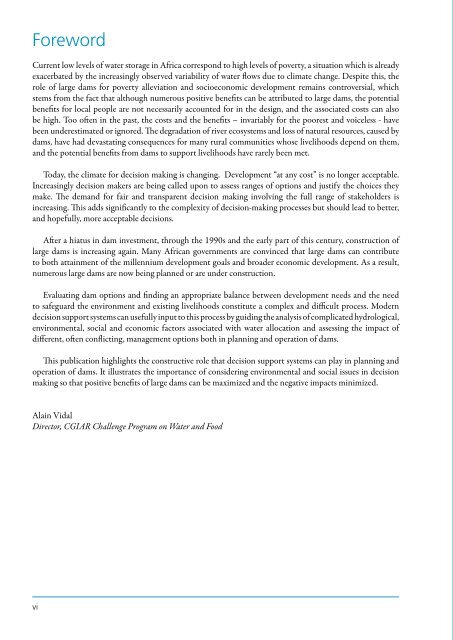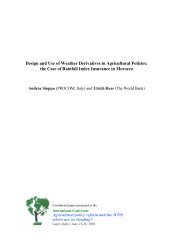Use of decision support systems to improve dam planning and dam ...
Use of decision support systems to improve dam planning and dam ...
Use of decision support systems to improve dam planning and dam ...
You also want an ePaper? Increase the reach of your titles
YUMPU automatically turns print PDFs into web optimized ePapers that Google loves.
Foreword<br />
Current low levels <strong>of</strong> water s<strong>to</strong>rage in Africa correspond <strong>to</strong> high levels <strong>of</strong> poverty, a situation which is already<br />
exacerbated by the increasingly observed variability <strong>of</strong> water flows due <strong>to</strong> climate change. Despite this, the<br />
role <strong>of</strong> large <strong>dam</strong>s for poverty alleviation <strong>and</strong> socioeconomic development remains controversial, which<br />
stems from the fact that although numerous positive benefits can be attributed <strong>to</strong> large <strong>dam</strong>s, the potential<br />
benefits for local people are not necessarily accounted for in the design, <strong>and</strong> the associated costs can also<br />
be high. Too <strong>of</strong>ten in the past, the costs <strong>and</strong> the benefits – invariably for the poorest <strong>and</strong> voiceless - have<br />
been underestimated or ignored. The degradation <strong>of</strong> river eco<strong>systems</strong> <strong>and</strong> loss <strong>of</strong> natural resources, caused by<br />
<strong>dam</strong>s, have had devastating consequences for many rural communities whose livelihoods depend on them,<br />
<strong>and</strong> the potential benefits from <strong>dam</strong>s <strong>to</strong> <strong>support</strong> livelihoods have rarely been met.<br />
Today, the climate for <strong>decision</strong> making is changing. Development “at any cost” is no longer acceptable.<br />
Increasingly <strong>decision</strong> makers are being called upon <strong>to</strong> assess ranges <strong>of</strong> options <strong>and</strong> justify the choices they<br />
make. The dem<strong>and</strong> for fair <strong>and</strong> transparent <strong>decision</strong> making involving the full range <strong>of</strong> stakeholders is<br />
increasing. This adds significantly <strong>to</strong> the complexity <strong>of</strong> <strong>decision</strong>-making processes but should lead <strong>to</strong> better,<br />
<strong>and</strong> hopefully, more acceptable <strong>decision</strong>s.<br />
After a hiatus in <strong>dam</strong> investment, through the 1990s <strong>and</strong> the early part <strong>of</strong> this century, construction <strong>of</strong><br />
large <strong>dam</strong>s is increasing again. Many African governments are convinced that large <strong>dam</strong>s can contribute<br />
<strong>to</strong> both attainment <strong>of</strong> the millennium development goals <strong>and</strong> broader economic development. As a result,<br />
numerous large <strong>dam</strong>s are now being planned or are under construction.<br />
Evaluating <strong>dam</strong> options <strong>and</strong> finding an appropriate balance between development needs <strong>and</strong> the need<br />
<strong>to</strong> safeguard the environment <strong>and</strong> existing livelihoods constitute a complex <strong>and</strong> difficult process. Modern<br />
<strong>decision</strong> <strong>support</strong> <strong>systems</strong> can usefully input <strong>to</strong> this process by guiding the analysis <strong>of</strong> complicated hydrological,<br />
environmental, social <strong>and</strong> economic fac<strong>to</strong>rs associated with water allocation <strong>and</strong> assessing the impact <strong>of</strong><br />
different, <strong>of</strong>ten conflicting, management options both in <strong>planning</strong> <strong>and</strong> operation <strong>of</strong> <strong>dam</strong>s.<br />
This publication highlights the constructive role that <strong>decision</strong> <strong>support</strong> <strong>systems</strong> can play in <strong>planning</strong> <strong>and</strong><br />
operation <strong>of</strong> <strong>dam</strong>s. It illustrates the importance <strong>of</strong> considering environmental <strong>and</strong> social issues in <strong>decision</strong><br />
making so that positive benefits <strong>of</strong> large <strong>dam</strong>s can be maximized <strong>and</strong> the negative impacts minimized.<br />
Alain Vidal<br />
Direc<strong>to</strong>r, CGIAR Challenge Program on Water <strong>and</strong> Food<br />
vi





